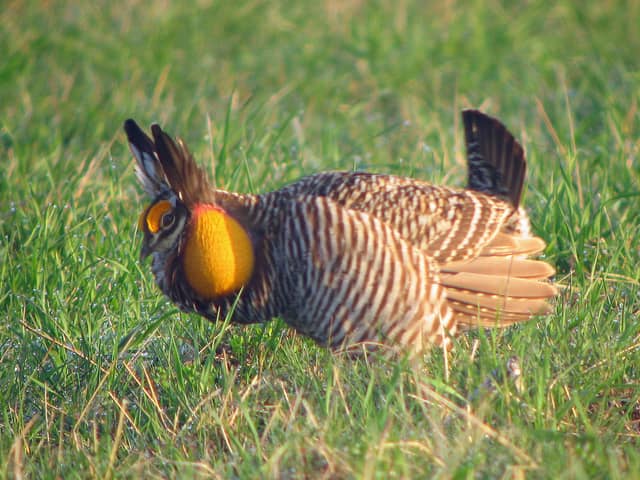Weather Gives Endangered Prairie Chickens a Nesting Boost in Missouri
OutdoorHub 08.30.11

KANSAS CITY, Mo — Missouri’s endangered prairie chickens got a major lift this summer from dry weather in June and continued refinement in how native grasslands are managed.
The Missouri population dipped to a critically low number of about 100 prairie chickens sighted on mating grounds this spring, in a state that once had hundreds of thousands. However, favorable weather helped hens on MDC-managed prairies hatch and rear their young this summer.
“We had an apparent nesting success of almost 80 percent, which is phenomenal,” said Max Alleger, grassland bird coordinator for the Missouri Department of Conservation (MDC). “Most studies show that nesting success in stable populations is usually 50 percent.”
Habitat loss since the 1800s reduced the state’s prairie-chicken numbers to dozens in scattered flocks as this century began. Starting in 2007, cool and rainy weather caused severe chick mortality during nesting and brood-rearing seasons, causing problems for a struggling species where adults have an average life span of two to three years due to predators and natural mortality.
In 2008, MDC crews began trapping prairie chickens in Kansas and releasing them at the Wah’Kon-Tah Prairie near El Dorado Springs. A small native flock survived at the Taberville Prairie Conservation Area to the north, but no prairie chickens remained at Wah’Kon-Tah as the translocation project began. The Kansas birds began a new flock, but torrential rains and unseasonably cool temperatures limited nesting success each spring through 2010.
Then relatively dry weather this June coupled with good variety in nesting and feeding habitat brought a welcome surge in brood counts and the number of chicks reaching a self-reliant size by summer’s end.
MDC crews located 29 prairie-chicken nests this summer at Wah’Kon-Tah and Taberville prairies in St. Clair County. Of those, they determined that hens in 23 nests hatched broods. Biologists and students from the University of Missouri-Columbia directly observed 52 chicks during field work.
“It’s encouraging,” Alleger said, “and we’ve seen the same thing with turkeys and quail. I think the dry weather helped all the ground-nesting birds.”
Three broods were raised by hens hatched at Wah’Kon-Tah since 2008. Hens from translocations in earlier years reared eight broods, and 16 hens translocated from Kansas this spring produced young.
Crews are able to monitor prairie chickens because many are outfitted with small radio transmitters. Biologists track them in the fields and chart on maps what habitat they use for feeding, nesting, loafing and roosting.
“The birds have shown a real preference for cattle-grazed areas, both on our native prairies and on neighboring private pastures as well,” Alleger said.
Prairie chickens are fast flyers but they spend most of their time walking, running, feeding and resting on the ground. Grazing opens up paths and open areas that are easy for prairie chickens to move about amid grasses and wildflowers, and they are easier places for small chicks to catch bugs while feeding. But the ground dwellers also need dense cover for nesting or to escape from predators such as hawks. The public prairies are being managed in 40-acre patches so that grazed, burned and undisturbed areas are side by side, offering what biologists call a soft edge.
“The chicks need to be able to get out in the sun in the morning and let the dew dry off,” Alleger said. “But when the hawks fly over, they also need places to hide.”
A five-year prairie-chicken restoration program at Wah’Kon-Tah with translocated Kansas birds, radio telemetry monitoring and habitat studies concludes in 2012.
This summer’s brood success is a hopeful sign that with moderate weather and habitat management such as grazing, the iconic symbol of grassland birds can rebound there and be restored elsewhere.
“If we can get two or three years in a row with drier weather,” he said, “it could make all the difference in the success of the project.”

